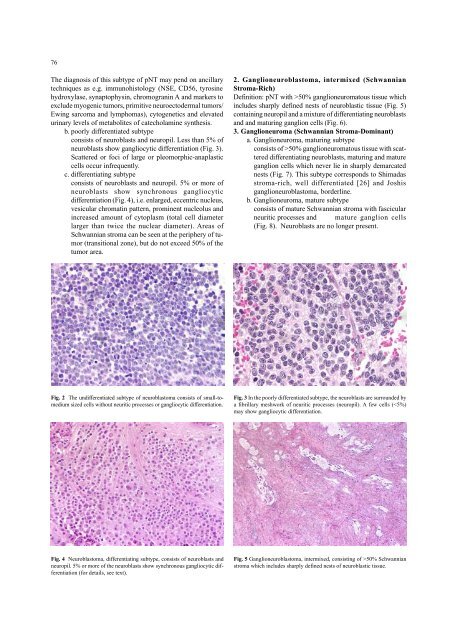Annals of Diagnostic Paediatric Pathology
Annals of Diagnostic Paediatric Pathology
Annals of Diagnostic Paediatric Pathology
You also want an ePaper? Increase the reach of your titles
YUMPU automatically turns print PDFs into web optimized ePapers that Google loves.
76<br />
The diagnosis <strong>of</strong> this subtype <strong>of</strong> pNT may pend on ancillary<br />
techniques as e.g. immunohistology (NSE, CD56, tyrosine<br />
hydroxylase, synaptophysin, chromogranin A and markers to<br />
exclude myogenic tumors, primitive neuroectodermal tumors/<br />
Ewing sarcoma and lymphomas), cytogenetics and elevated<br />
urinary levels <strong>of</strong> metabolites <strong>of</strong> catecholamine synthesis.<br />
b. poorly differentiated subtype<br />
consists <strong>of</strong> neuroblasts and neuropil. Less than 5% <strong>of</strong><br />
neuroblasts show gangliocytic differentiation (Fig. 3).<br />
Scattered or foci <strong>of</strong> large or pleomorphic-anaplastic<br />
cells occur infrequently.<br />
c. differentiating subtype<br />
consists <strong>of</strong> neuroblasts and neuropil. 5% or more <strong>of</strong><br />
neuroblasts show synchronous gangliocytic<br />
differentiation (Fig. 4), i.e. enlarged, eccentric nucleus,<br />
vesicular chromatin pattern, prominent nucleolus and<br />
increased amount <strong>of</strong> cytoplasm (total cell diameter<br />
larger than twice the nuclear diameter). Areas <strong>of</strong><br />
Schwannian stroma can be seen at the periphery <strong>of</strong> tumor<br />
(transitional zone), but do not exceed 50% <strong>of</strong> the<br />
tumor area.<br />
2. Ganglioneuroblastoma, intermixed (Schwannian<br />
Stroma-Rich)<br />
Definition: pNT with >50% ganglioneuromatous tissue which<br />
includes sharply defined nests <strong>of</strong> neuroblastic tissue (Fig. 5)<br />
containing neuropil and a mixture <strong>of</strong> differentiating neuroblasts<br />
and and maturing ganglion cells (Fig. 6).<br />
3. Ganglioneuroma (Schwannian Stroma-Dominant)<br />
a. Ganglioneuroma, maturing subtype<br />
consists <strong>of</strong> >50% ganglioneuromatous tissue with scattered<br />
differentiating neuroblasts, maturing and mature<br />
ganglion cells which never lie in sharply demarcated<br />
nests (Fig. 7). This subtype corresponds to Shimadas<br />
stroma-rich, well differentiated [26] and Joshis<br />
ganglioneuroblastoma, borderline.<br />
b. Ganglioneuroma, mature subtype<br />
consists <strong>of</strong> mature Schwannian stroma with fascicular<br />
neuritic processes and mature ganglion cells<br />
(Fig. 8). Neuroblasts are no longer present.<br />
Fig. 2 The undifferentiated subtype <strong>of</strong> neuroblastoma consists <strong>of</strong> small-tomedium<br />
sized cells without neuritic processes or gangliocytic differentiation.<br />
Fig. 3 In the poorly differentiated subtype, the neuroblasts are surrounded by<br />
a fibrillary meshwork <strong>of</strong> neuritic processes (neuropil). A few cells (50% Schwannian<br />
stroma which includes sharply defined nests <strong>of</strong> neuroblastic tissue.
















